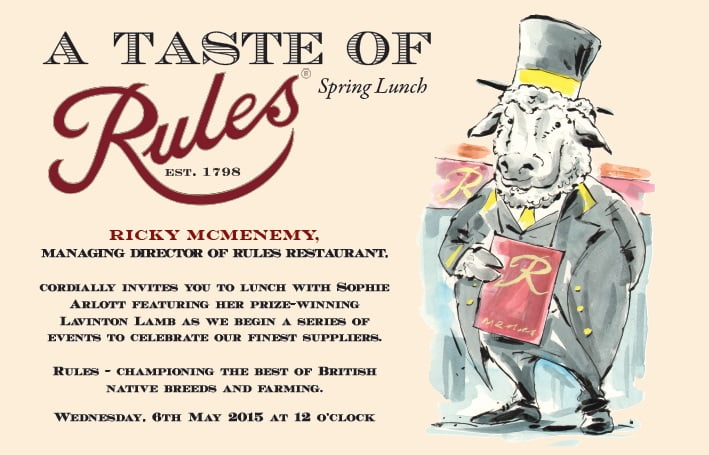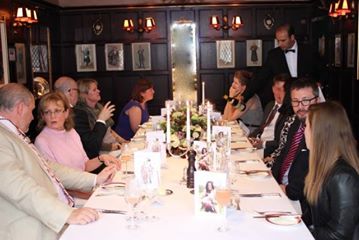Last Wednesday we were thrilled that Rules, London’s oldest restaurant, put on a fabulous lunch for us. The lunch, where Sophie gave a talk and showed a film, was attended by a number of high-profile journalists, farming and gastronomy figures, including Mark Hedges, editor of Country Life; Kate Hawkings, chairwoman of the Guild of Food Writers; Shane Holland, Executive Chairman of Slow Food UK; Sally Coffey, editor of Britain Magazine; freelance writer and editor Jennifer Sharp; and fellow shepherdess and blogger Rosie Hetherington.


Ricky McMenemy, MS of Rules, put on a wonderful day, starting with drinks in the beautiful bar, followed by an amazing lunch in the private dining room prepared by Rules chef David Stafford, with lots of fabulous wine.
The lunch was the first of a series Rules are hosting called “A Taste of Rules”, to celebrate their (British) suppliers.
Sophie gave a talk about how she started her Lavinton Lamb business, and her passion for breeding traditional British sheep which produce great-tasting lamb: quality over size. The guests were shown a new film about Lavinton Lamb, which was made in association with Rules Restaurant – to be available on our Social Media channels soon.
“I’ve been breeding pedigree Southdown sheep for the last 12 years. I started off with a small flock of about 20 ewes, breeding them showing them and winning prizes at county agricultural shows and producing a few lambs for the family table and freezer.
Lavinton Lamb came about because a few years ago, my brother and sister and their families were visiting us for Easter and I only had one joint of my own homegrown Southdown lamb left in the freezer so I went to the local butcher – a proper butcher with a good reputation and bought another joint of lamb.
They both looked almost identical and I cooked them both in exactly the same way but when we came to eat them, the Southdown was sweet, succulent and full of flavour and the joint I had bought from the butcher tasted of nothing at all really, with just a hint of cardboard!
I was furious – why were we as consumers eating tasteless lamb when we could be eating lamb packed with flavour. Consumers were being duped, being cheated! So I decided to do something about it … and Lavinton Lamb was born.
I feel I’m in a bit of a minority when it comes to sheep farming. I breed lamb for flavour. Most modern livestock farming is all about producing meat as quickly as you can, as big as you can and as cheaply as you can.And along the way the flavour has been forgotten.
Chicken is a meat that has suffered perhaps more than any when it comes to taste. A few months ago I was chatting with a local farmer who was telling me about modern day poultry farming in Spalding, about 20 miles from where I live. Here – a large chicken production plant owned by an extremely large multinational company has managed to produce a chicken by converting grain into muscle super efficiently from hatch to dispatch in just 28 days!!! This one plant slaughters close to 9 million chickens a week. Intensive farming at its most efficient.
Philip Walling in his book Counting Sheep says:
This process seems so brutally industrial .. reducing the creature to its function, stripped of all sentiment and consideration of beauty.’
Surely for the happiness and contentment of an animal it must display its natural behaviour – it must feel the sun on its back and feel the rain in its face. This is essential for its own wellbeing – it must affect the animal in every sense including, in the end, the flavour of its meat.
It is possible to farm sheep naturally and with compassion, and to eat lamb with flavour, but this means that you can’t use the modern continental breeds such as aTexel and Charrollais that are all muscle and no fat. It means you have to use a breed that has some natural marbling in the muscle – intramuscular fat – like the native Southdown. It means you must use a breed that takes time to mature and will fatten on grass, rather than on large amounts of concentrated protein feed.
We can eat British lamb all year round. For example, my different breeds breed and fatten at different times of the year. In spring and early summer my Southdown x Romney x Lleyns are ready (which we are eating today), and later in the autumn my Southdown x Hebrideans, which you saw on the film, start to fatten. And then eat the full flavoured hogget and mutton in the winter months.
There are 60 different breeds of sheep in Britain which have all adapted to their own peculiar environment depending which part of the country they have made their own.
The golden thread that runs through the history of the British countryside. To quote Philip Walling:
‘It is time to question what we eat and become more discerning and demanding about the quality and taste of our food. It’s time to value our meat – after all an animal has died for us to eat it.’
It’s time to celebrate our food and for EVERYONE to enjoy the flavour of our native British lamb.
These are issues I am passionate about.
“I love real food with real flavour and I’m doing something about it. Lavinton produces lamb with flavour – as it ought to be!”